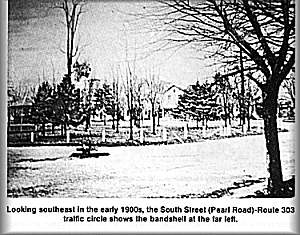 |
 |

|
A history of the community And its families
As published in the Brunswick Times Transcribed by Gerri Gornick)
It was the early 1930s and the Great Depression had hit everywhere. Yet, the automobile had already made great inroads into the American way of life and Brunswick would soon be well known to motorists.
Perhaps it was the effect of the depression when everyone had to look out for himself and earn money any way he could, or the fact that many motorists seemed to abuse the speed limit and the traffic light. But Brunswick became known as one of the most notorious towns in the United States as a speed trap. Myron Chidsey, who as a trustee at the time along with V. E. Morton and Bert Keller, relates what was happening back then. "Most people were used to coming upon a traffic circle," he said. "So I think when they didn't encounter one, they felt they hadn't reached town yet and just kept speeding through - many times crashing the light. It was a problem." But then, so was the solution. An enterprising constable, elected by the voters of Brunswick, and a justice of the peace, also elected, decided to team up and do something about it. And because of them the town became the scandal of the area. Constable Walter Petschler would regularly pick up speeders and light crashers. He would immediately take them to J. P. Martin Lutz who owned a greenhouse just west of the center on Route 303 where immediate fines would be levied. The "court" would most often suspend the fine but would collect "$10.60 in costs, according to Chidsey. Then $4.40 went to Petschler and Lutz got $6.20 - an amount Chidsey thought had been set by law. Motorists began to complain and the AAA did something about it. They came out and posted warning signs at the entrances of town to tell motorists the speed limit was strictly enforced. They also warned in their literature. Merchants were hurt by the reputation and began to object to the practice. But the men were elected officials. The trustees, Chidsey said, went to the county prosecutor who gave them permission to take down the signs - but it was the only action they were allowed to take. And it seems that no one was inclined to vote them out of office. According to Elmer Benjamin, another lifelong resident, the men never bothered Brunswick residents. "Back then, everyone knew everyone else, so it was easy to tell who were the strangers through town. You could do almost anything if you were a resident." The AAA didn't think it was funny and they instituted an investigation and continued the warning. Motorists reported that Petschler was taking advantage of them. "It's not inconceivable," said Chidsey. "It was a trip light triggered from Route 303 going west. So perhaps one could park on Route 303 and wait for a car to come along. He could drive over the triggering mechanism and, with some practice, could trip the light right before a car went through - and the car would most likely crash the light."  It never go to be an election issue, Chidsey says, because most elected officials were "drafted," they didn't usually seek to run. He said he imagined even Petschler and Lutz didn't really campaign. In the late 1930s or early 1940s, the state began an investigation of the men and the alleged speed trap but everything came to a halt when the Lutz greenhouse burned down, taking all the records of past offenders and offenses with it. After that, Lutz moved away and Petschler chose not to run again. Their successors apparently chose not to continue the scandalous practice and all was well again. But to this day some people still remember Brunswick as a speed trap.
|
